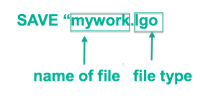Saving And Loading Files
There are two ways to save in Logo. One is the traditional method shown below of choosing Save… from the File menu. The other is in keeping with text-based programming and is important for students to learn in their programming journey. Choose the method that best aligns with your age group and goals of your classroom.
For new and younger users you will probably want to start with the
traditional File>Save… option as described below. Please review the different
files types for saving. However when your students are ready, have your
students use the SAVE command. By doing this you are introducing your
students to a realistic programming environment. Following is an example
of how to use the SAVE command.
Please note that the Web version cannot save to any disk location because of security restrictions. The Web version always saves to the computer’s Downloads folder.
SAVE Command
SAVE “MYWORK.LGO

Save with menu toolbar
To save using the menu, select File from the toolbar, then select Save…. A dialog appears with six choices.

Saving Files
What to Save?
Workspace as Logo File (.lgo)
Saves all procedures as well as the global names and property lists, including the current preferences (as the PREFS property list), as a text file with the extension “.lgo”. You can edit the file with any editor, or load it back into the Logo workspace or into the Logo editor.
Environment (.logoenv)
Saves everything in the Listener panel, Graphics panel, and Editor panel, as well as any procedures, names, and property lists created. This is the best choice for students who are working on a project or new to Logo; when you load a .logoenv file, Logo restores the complete enviroment to the state that was saved.
Editor Contents (.lgo)
Saves what is currently being written in the Editor panel. This is a good choice if a student is working on a procedure in an editor panel and is not finished, or if the student loaded a “.lgo” file into the editor.
Picture (.png)
Saves the Graphics panel as a graphic image in a .png format.
Blocks File (.xml)
Saves the contents of the Blocks panel as an XML file.
Opening Files
What to Open?
To load (open) a file, select File from the toolbar menu, and then select Load…. A dialog appears with six choices.

Workspace from Logo File (.lgo)
Loads and runs the contents of the LGO program file, which can be the result of a Save Logo File or a Save Editor Contents operation.
Environment (.logoenv)
Loads the total environment for that file: everything in the Listener panel, Editor panel, Graphics panel, and any procedures created. This is the best choice for students who are working on a project or new to Logo.
Into Editor (.lgo)
Loads the file into the Editor panel so the student can edit the contents and load them into the workspace when done.
Picture (.png)
Loads a .png image in the Graphics panel as a background for other graphics.
Blocks File (.xml)
Loads an XML file with Logo blocks code into the Blocks panel and switches Logo to Blocks layout.
